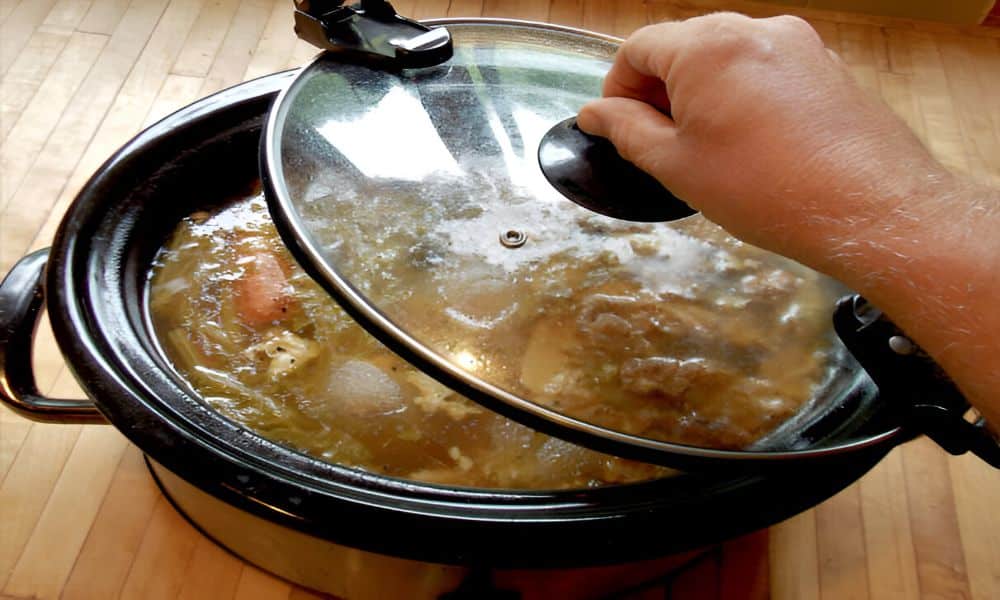I once looked at beef fat as waste. After trimming a roast, I’d toss it in the bin. But one day, I paused. I remembered stories of how older generations turned scraps into something useful. That’s how I learned how to render beef fat in a slow cooker.
Now, I see it as a gift. Rendered fat makes eggs tastier, potatoes crispier, and leftovers special. It’s easy and slow. It’s worth it.
This guide walks you through each step. No rush. No pressure. Just honest kitchen magic. You’ll turn fat into flavor—and feel proud doing it.
What Is Beef Fat (and Why You Should Save It)
It comes from the parts you usually trim away. You’ll find it around the edges of steaks or tucked deep inside cuts like brisket. Some call it suet. Once melted and strained, it becomes tallow.
That change is what makes it special. Raw fat feels greasy. But rendered tallow is smooth, clean, and rich. It stores well and has many uses.
Beef tallow brings deep flavor to simple foods. Fry an egg in it, and you’ll see what I mean. It also works in pie crusts, roasted veggies, and even soaps.
Why I Prefer the Slow Cooker Method
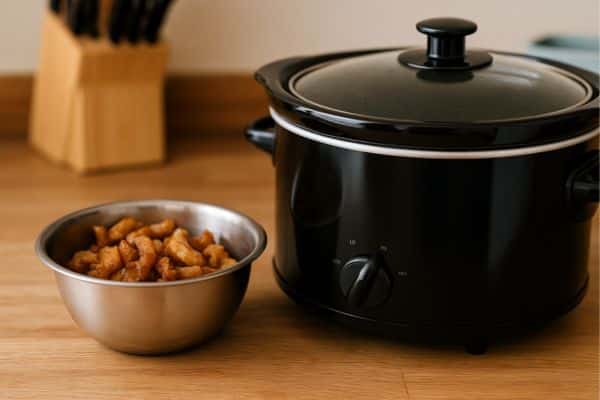
I’ve tried rendering beef fat on the stove. It works—but it’s tricky. The heat gets uneven. The fat pops. The smell can fill the whole house fast.
Now I always render fat in a slow cooker. It’s gentle and steady. No splatter. No stress. I set it to low and let it work on its own.
This method feels calm. It fits right into busy days. While I clean or cook something else, the slow cooker hums along.
It’s one of the easiest cooking methods I know—and the results are better every time.
Tools and Ingredients You’ll Need
Here’s a simple list to keep things easy:
- A slow cooker (any size works)
- A sharp knife and cutting board
- A fine strainer or cheesecloth
- One or two clean glass jars
- A ladle or large spoon
Optional tools include a funnel for clean pouring and a splash of water to help at the start.
Step-by-Step Guide
01. Chop the Fat into Small Pieces
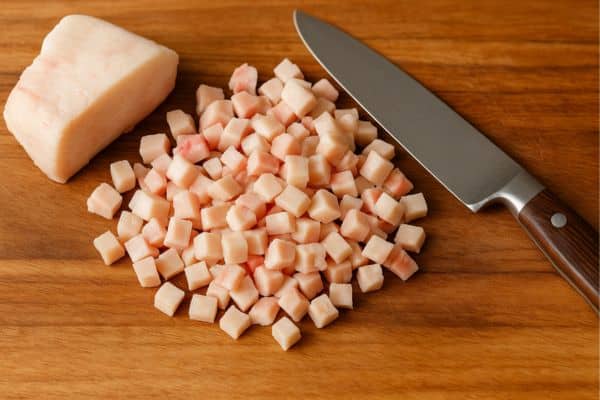
Start with clean, raw or suet. Use a sharp knife to cut it into small chunks—about half an inch. Smaller pieces melt faster and more evenly.
02. Optional—Freeze Before Cutting
Cold fat is easier to cut. Toss it in the freezer for 30 minutes before chopping. This helps it stay firm, not sticky.
03. Add to the Slow Cooker (With or Without Water)
Place the chopped fat into the slow cooker. A small splash of water can help prevent sticking, but it’s optional and steams off as it cooks. For small batches, the best slow cookers for one person work perfectly and keep the process simple.
04. Set to LOW and Leave the Lid Off
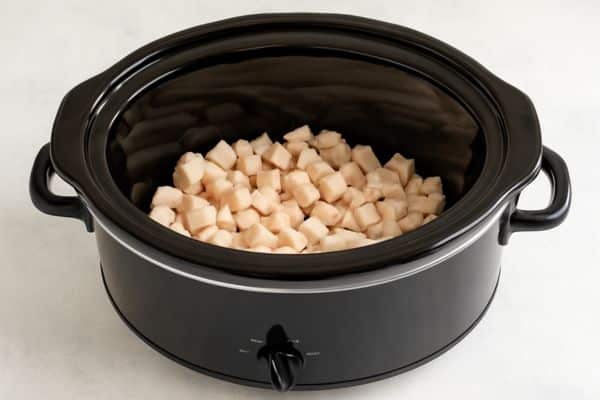
Turn the slow cooker on LOW. Keep the lid off so steam can escape. This prevents extra moisture from building up.
05. Stir Occasionally and Watch for Liquid
Give it a gentle stir once or twice. Over time, the golden liquid will rise as melts. Let it cook for 5–6 hours.
06. Strain with Cheesecloth
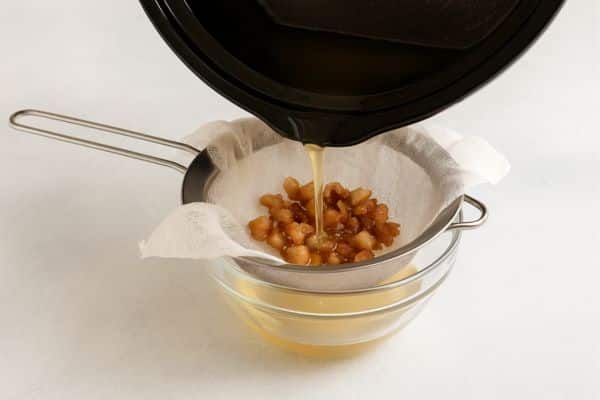
Once the pieces shrink and turn crispy, it’s time to strain. Pour the hot liquid through cheesecloth or a fine mesh strainer into a bowl or jar. This removes any leftover bits.
07. Store in Jars and Let It Cool
Pour the clean fat into glass jars. Let it cool at room temperature. It will turn white and creamy. Store it in the fridge for later.
And that’s it. That’s how to make beef tallow at home—no stress, no mess. This method also works great to render suet at home for cooking or saving.
Pro Tips for Best Results
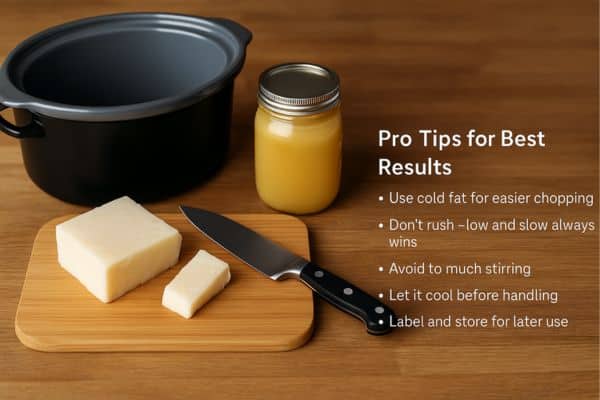
I’ve rendered fat many times. These simple tips make the process smooth and safe every time.
Use cold fat for easier chopping
Fat gets sticky at room temperature. A short chill in the freezer makes it firm and easy to cut.
Don’t rush—low and slow always wins
High heat can burn the fat and ruin the flavour. Patience gives you clean, golden tallow every time.
Avoid too much stirring
One or two gentle stirs is plenty. Over-stirring can break up the bits and cloud the liquid.
Let it cool before handling
Hot fat is dangerous. Always cool it down a bit before pouring or moving the jar.
Label and store for later use
Homemade tallow keeps well, but it’s easy to forget what’s what. Use a marker and date the jar.
These cooking fat tips come from real practice. They’ll help you avoid a mess and get better results with every batch. Once you try these homemade tallow tricks, rendering will feel easy.
What to Do With Leftover Cracklings
After you render the fat, you’ll find tiny crispy bits left behind. These are called cracklings. Don’t throw them away—they’re full of flavour.
It cracklings add a nice crunch to many dishes. I like to sprinkle them over scrambled eggs. You can also toss them on salads, baked potatoes, or into warm rice.
Want a quick snack? Add a pinch of salt and enjoy them straight from the bowl.
Best Ways to Use Rendered Beef Fat
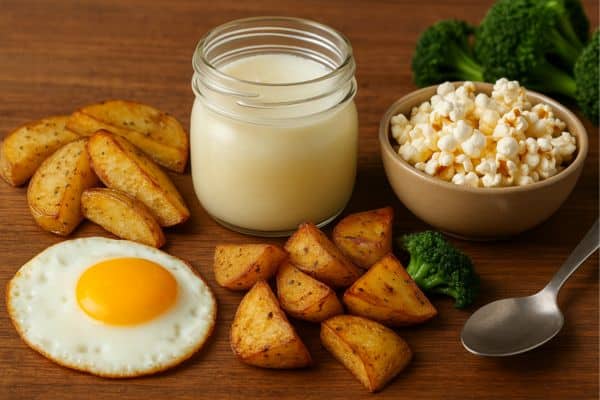
Once you have a jar of clean, white tallow, the fun begins. This fat adds deep flavor to simple meals.
Start with the basics. Fry eggs in it for a rich taste and crispy edges. Use it to roast potatoes—they come out golden and crisp. Drizzle a spoonful over veggies before baking for a warm, savoury touch.
One of my favourites? Popcorn. Just a spoonful gives it a bold, buttery flavour without butter.
There are many beef tallow uses, from frying to baking.
Frequently Asked Questions
How long does rendered beef fat last?
Stored in a sealed jar in the fridge, tallow can last for months. Some people freeze it to make it last even longer. Its shelf life is one of the reasons I love it.
Can I render pork fat the same way?
Yes, you can. The steps are nearly the same. Pork fat turns into lard, which works great for baking and cooking.
Do I need to refrigerate beef fat?
For best results, yes. Storing tallow in the fridge keeps it firm, fresh, and safe to use for weeks. It’s one of my favourite safety tips.
Final Thoughts
It often gets tossed without a second thought. But now you know better. It’s rich, useful, and full of flavour.
By learning how to render beef fat in a slow cooker, you turn scraps into something valuable. You save money And cut waste. You cook with a deeper taste.
Give it a try in your kitchen. Keep it simple. Trust the process. And enjoy every spoonful.


